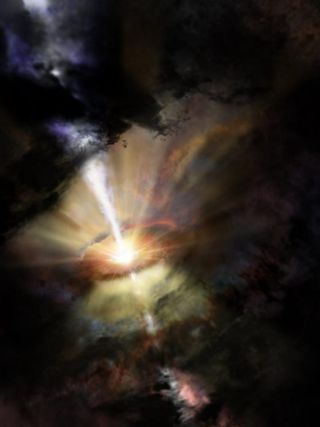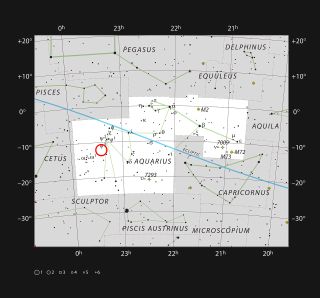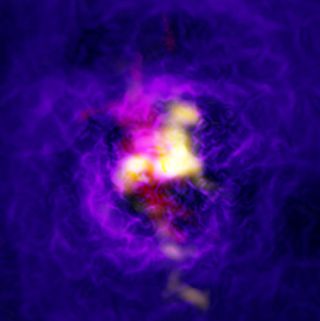A Monster Black Hole Powers This Cosmic Fountain a Billion Light-Years Away (Video)
A monster black hole acts like a pump in a cosmic fountain, spouting and siphoning matter, according to unprecedented new observations.
Researchers have, for the first time, detected cold molecular gas funneling into and spraying out of a black hole within the same system. This provides evidence that both events occur in one grand process, officials from the European Southern Observatory (ESO) said in a statement. ESO operates and acts as a major partner for two instruments that collected data in this study.
Every large galaxy, such as the Milky Way, has a supermassive black hole at its center, according to NASA. According to the study, cold gas flying outward from the center eventually falls back to the center of the galaxy, where a black hole's gravitational pull keeps the torrential process going. [This Trippy Simulation Shows How Monster Black Holes Glow Before They Collide]

The new work focuses on an observation of a single celestial case, but the team speculated that the fountain phenomena may be common, National Radio Astronomy Observatory (NRAO) officials said in another statement. On behalf of North America, NRAO leads and operates a radio telescope site called ALMA that made observations for this research. The findings could help "trace processes fundamental to galaxy evolution," researchers said in their study, published Sept. 17 in the Astrophysical Journal.
The enormous black hole observed in the study is relatively near to Earth. It churns 1 billion light-years away, in the constellation Aquarius, within an elliptical galaxy at the center of the Abell 2597 galaxy cluster.
The team made a combined analysis of Abell 2597 by using several instruments. Data from MUSE, the Multi Unit Spectroscopic Explorer on ESO's Very Large Telescope in Chile, revealed warm, ionized gas shooting out of the central galaxy. And ALMA, ESO's Atacama Large Millimeter/Submillimeter Array (also in Chile), found clumps of frigid, molecular gas in the same place, falling back into the black hole.

"The unique aspect here is a very detailed coupled analysis of the source, using data from ALMA and MUSE," Grant Tremblay, a researcher at the Harvard-Smithsonian Center for Astrophysics and lead author on the new work, said in ESO's statement. "The two facilities make for an incredibly powerful combination."
Get the Space.com Newsletter
Breaking space news, the latest updates on rocket launches, skywatching events and more!
These facilities' observations, combined with an ultradeep observation by NASA's Chandra X-Ray Observatory, revealed the heated regions of this fountain in detail.
The researchers painted a full picture of the action at the galaxy's heart. Frigid gas clouds that drop to temperatures of minus 260 degrees Celsius (minus 436 degrees Fahrenheit) drain toward the monster black hole. This activity powers fast-moving jets spewing plasma, a blazing ionized gas. Once the plasma is out in the void of space, it cools down.
But because the jets aren't moving faster than the escape speed from the galaxy, the cooling clumps fall back toward the center to the black hole — as researchers said, "keeping the fountain long-lived."

Follow Doris Elin Salazar on Twitter@salazar_elin. Follow us @Spacedotcom, Facebook and Google+. Original article on Space.com.
Join our Space Forums to keep talking space on the latest missions, night sky and more! And if you have a news tip, correction or comment, let us know at: community@space.com.

Doris is a science journalist and Space.com contributor. She received a B.A. in Sociology and Communications at Fordham University in New York City. Her first work was published in collaboration with London Mining Network, where her love of science writing was born. Her passion for astronomy started as a kid when she helped her sister build a model solar system in the Bronx. She got her first shot at astronomy writing as a Space.com editorial intern and continues to write about all things cosmic for the website. Doris has also written about microscopic plant life for Scientific American’s website and about whale calls for their print magazine. She has also written about ancient humans for Inverse, with stories ranging from how to recreate Pompeii’s cuisine to how to map the Polynesian expansion through genomics. She currently shares her home with two rabbits. Follow her on twitter at @salazar_elin.
